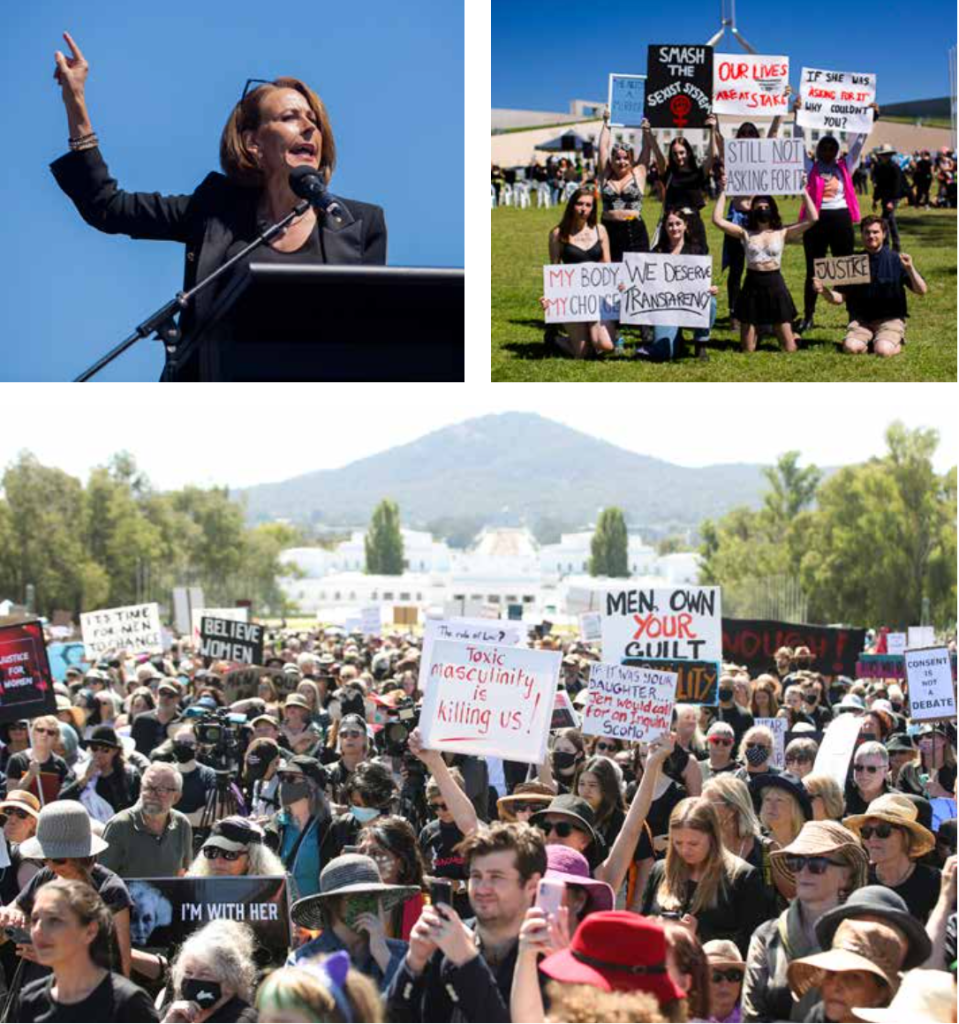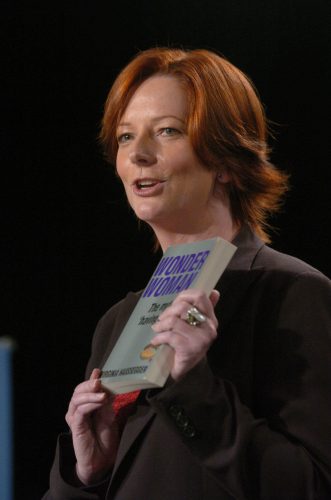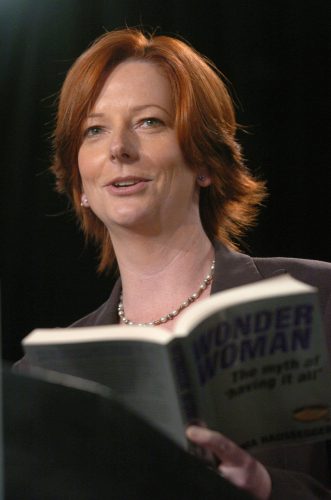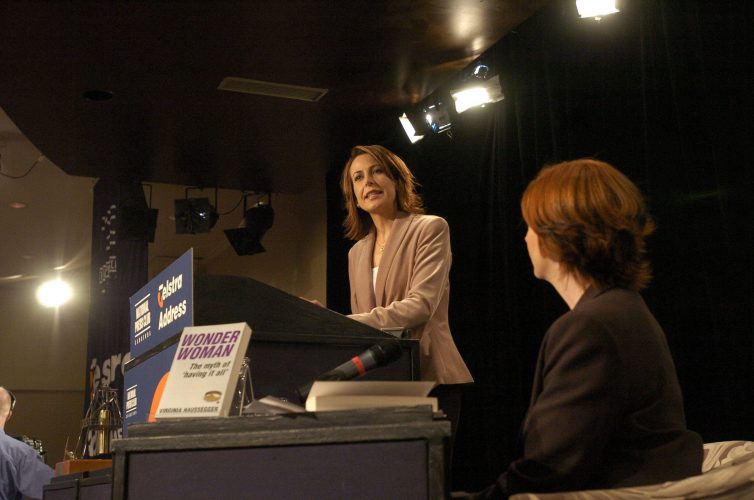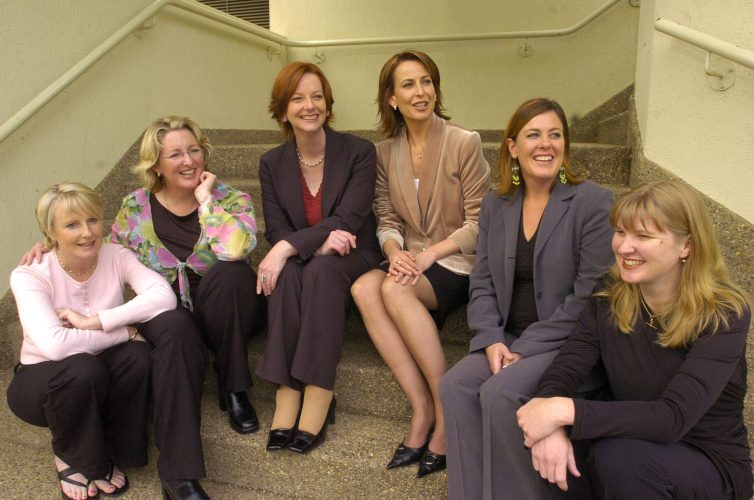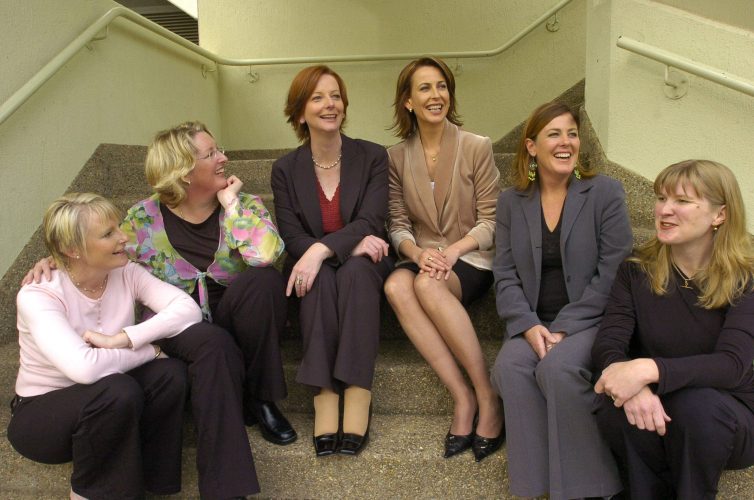What is feminine power? It’s not a trick question. But think about it too long, and soon you’re caught in a maze of linguistic riddles. Even that oracle of feminist wisdom herself, Professor Mary Beard, struggled to articulate a media friendly, sound-bite answer. Instead she cut to the chase: it is a little difficult to define, was her short answer.
That said, the National Museum of Australia’s splendid exhibition, Feared and Revered: Feminine Power through the Ages, contains what Beard insists are some of “the most arresting images ever made”. While some are divinely beautiful and serene, others are squat, menacing, ugly and threatening. Some are manifestations of females who clearly brook no fools. There are gorgeous Ancestral beings such as the Yawkyawk from Arnhem Land, who float and shimmer like ethereal spirits, half female, half scaley fish. Others display ambiguous gender: breasts and vagina, yet male face and goatee beard. A bit of this, a bit of that. A provocative mirror to contemporary power perhaps? An insight to ancient roots of gender fluidity? Or maybe a useful prod to remind us of the value of diversity in leadership?
However you look at it, this magnificent collection forces us to think hard about our own preconceived notions of what it is to be female, and what constitutes ‘feminine power’. Walking through this temple like space, sweeping 5,000 years, I was deeply struck by an overwhelming sense of endurance. The endurance of female power, in its all its transformative and unique manifestations, vibes throughout this exhibition.
Then the penny drops. Like a clanger.
At what point in time, from ancient through to modern history, did we narrow our view of the feminine so thoroughly that we lost touch with the multifaceted female complexity that is so overtly on display here? When did modern era culture lose sight of the rich, diversity of the feminine? When did we box her into the singular contemporary mould of mother, wife, carer? A mould shaped to provide primary support for hegemonic masculinity and to prop up patriarchal power.
One of the few female deities to survive the passage of time with her full feminine powers intact, is that modern-day multitasker Laksmi. An ancient Hindu goddess, Shri-Lakshmi is aided in her numerous chores by four arms and two sets of hands. There was a beautiful and elegantly funny moment during the public panel discussion held to mark the launch of Feared and Revered, as Dame Quentin Bryce held the audience in rapture while she explained her fascination and passion for Lakshmi. “Well, she’s been very contemporary, really. She’s moved with the times”, she explained. Laksmi, a “bestower of power, wealth and good fortune”, has certainly survived millennia, not just because of her gifts of prosperity, but rather, according to Dame Quentin, her distinctly feminine character: “I’m drawn to the assurance, inner confidence, and sense of purpose in Lakshmi’s demeanour”, says Bryce. And let’s face it, what woman isn’t?
But it’s Dame Quentin’s take on the sorceress Circe, that perhaps resonates most. Circe, according to Dame Quentin, was a dab hand at creating wicked spells and deadly poisons, proving herself “strategic, gutsy, powerful and empowering”. Circe was famed for turning drunken men who slurp their wine into snorting pigs. For a moment we wonder if that may explain the origins of ‘male chauvinist pig’? But when Circe’s lover Odysseus leaves her for another woman, “with the baby and cleaning up to do”, according to Dame Quentin, it’s not the motherload on Circe’s mind, but rather her legacy and determination to pass on “her divine power to women across the world to give them courage and fortitude.”
So, with the spirit of Circe in mind, we return to that riddle of a question: what is feminine power?
What Feared and Revered helps us understand, thanks to the exhibition’s exquisite timing, is that whilst we may struggle to define what is meant by ‘feminine power’, as we roll through the first quarter of the 21st century one thing is clear: we all know feminine power when we see it. When we feel it. And right now in Australia and around the globe, we are witnessing an explosion of it!
The past few years have seen women and girls raise their voice and exert their unique feminine power in myriad ways we have not seen expressed before. Certainly not with such force and consistency. Using noisy, angry, public rallies and online advocacy campaigns, along with data driven demands for greater political representation and access to the levers of power, women are grabbing media headlines and forcing open new discussions, new thinking.
Far from ad-hoc, or merely reactionary, these actions are fuelled by sharp political insight, strategic creativity, technical savvy, and an enormous amount of youthful energy.
Around the world, women and girls are harnessing collective strength across international networks. They are retaliating against political exclusion; patriarchal control; misogyny; systemic inequity; gender-based violence and sexual harassment; restrictions on reproductive rights; and an alarming rise in anti-female fundamentalism intent on winding back women’s basic human rights.
Suddenly it seems women everywhere are ripe for a renegotiation of the rules. And it is feminine power that is forcing the change. What’s more – women are galvanising men. Drawing men and boys into their cause and leading them in a new style of changemaking, where unambiguous and unapologetic feminine power is out front and in charge.
We saw an uncompromising feminine power on furious display here in Australia on 15 March 2021, when over one hundred thousand women rallied in 40 locations around the nation at the March4Justice. Although hastily put together in less than three weeks, the anger and frustration that fuelled this gathering had been steadily building for years. Regardless of one’s politics, women across the nation were shocked and dismayed at the treatment and public humiliation endured by Australia’s first female Prime Minister, Julia Gillard. Her 2012 Misogyny speech – now celebrated by women around the world – gave voice to the internal dialogue and frustration all women feel in the face of daily acts of sexism, misogyny and crude disrespect. In the ensuring years the glaring lack of women in Australia’s federal parliament, the voicelessness of those that were there, and a rush of highly publicised allegations of sexual abuse and harassment from courageous young women prepared to publicly share their stories of vulnerability and shame, all fed into a powerful moment of reckoning in Australia.
I was one of a dozen speakers at the largest of the March4Justice gatherings. As I climbed onto the makeshift stage erected in front of Parliament House in Canberra, a sea of black clad women and a sprinkling of men stretched out in front of me, as far as the eye could see: a crowd of 15,000 protesters chanted “Enough is Enough”. Many were carrying signs berating sexism and demanding ‘Justice for Women’. The words were smart, funny, furious, prosaic and everything in between. From my vantage point I read out a few: ‘Smash the Patriarchy’, ‘My body, my choice’, ‘Hear us Roar’, ‘If she was asking for it why couldn’t you?’; and one of my favourites, “Cunty, Shit, Fuckery”. The crowd numbers were much bigger than we’d expected. This was huge for Australia. In my thirty years in journalism I had never seen a women’s rally that had swelled to anything like this size.
On stage I stood closely beside one of the national capital’s long-time feminist heroes, Biff Ward. At 80 years of age, Biff is an old pro at women’s rallies, but like me she too was staggered by the power of this gathering. “We can maintain our rage!” she bellowed. “We have reached critical mass. The days of the patriarchy are numbered. We’re counting down. Sisterhood is powerful!” With that she stepped back and we both raised our fists to the crowd. They went wild. I then stepped forward to the mic and bellowed to the sea of faces before me: “If you are not angry, you are not paying attention!” The roar in response was deafening. “This is a crystalising moment for Australia’s women” I yelled above the din, “But as a nation we must get this right. We must hear the myriad and complex reasons as to why women are so deeply aggrieved and angry.” I pushed on, “If those in power who hold the political policy leavers fail to act. Well, God help Australia!” The women below me again began chanting even louder, “Enough is Enough!”. I held up my hand to halt them and bellowed at the top of my voice, “The genesis for this new, energised movement began decades ago, and … We Are Not Finished Yet!” The crowd roared. I turned to Biff, who looked as stunned by the sheer noise of it all as I was. We hugged.
Assessing this phenomenal moment, in hindsight, is fascinating when put in context of what was occurring around the world at the same time, and continues to this day. Feminine power has its far-reaching tentacles – perhaps like Lakshmi’s multiple arms – active everywhere we look. The 2021 March4Justice followed similar demonstrations just days earlier in the UK, where tens of thousands spontaneously rallied in response to the brutal rape and murder of British woman Sarah Everard, and the rise of gender-based violence.
Only months earlier we saw feminine power explode on the streets of Argentina, during a parliamentary vote on reproductive rights, as hundreds of thousands of women waving green handkerchiefs and scarves – a colour synonymous with safe abortion – filled the streets of the capital demanding decriminalization. This ‘Green Wave’ women’s protest movement quickly swept right across Latin America and is still forcing legislative change in multiple jurisdictions. We’re also witnessing energised feminine power in Pro-Choice rallies across numerous US states right now, in response to the shock reversal of Roe vs Wade, which ended 50 years of a women’s constitutional right to abortion. We saw incredibly courageous examples of it take to the streets of Kabul in August 2021 and continue ever since, as exceptionally brave Afghan women protest against Taliban bans on female education, employment, and prohibition on their free movement.
We saw it on International Women’s Day 2022 when Mexican cities came to a standstill as millions of women throughout the country went on strike for ‘A Day Without Us’, in protest over escalating rates of femicide. We saw it again in the Mexican capital late last year, this time erupting into violent clashes with police, as purple clad women rallied on the International Day for the Elimination of Violence against Women. Simultaneous protests spread across the southern continent, from Buenos Aires to Bogota. And of course we are seeing it right now in over one hundred cities across Iran as hordes of courageous protestors continue to scream, ‘Women, Life, Freedom’. I saw it today in a social media post with a wobbly phone video showing dozens of young Iranian school girls throwing water bottles at their male teachers, as they screamed “Shame, Shame!”
Less visible on our narrow news radar, but just as active, women led protests are echoing around the globe, from Myanmar, to India, Ethiopia, Sudan, Nigeria, Yemen, Saudi Arabia, Columbia, Brazil and beyond.
Lit by a feminist fuse, decades in the stoking, feminine power has found its collective, global voice. And in 2023 it is showing every sign of growing louder and stronger. While feminist actions of previous generations have provided a blueprint for activism, these contemporary eruptions of female pushback are not necessarily driven by feminist ideology, nor informed by feminist theory. It is more basic than that. These are women and girls, the world over, who are responding to gender-based oppression by embracing their fundamental gender difference, in all its complexity. In embracing that difference, celebrating and parading it, they are exerting their own power. Their feminine power.
A decade ago I was travelling alone on a slow boat down the Irrawaddy River in what we then called Burma, now Myanmar: a nation in which women remain largely unrepresented in politics or public leadership. I fell into conversation with an elderly couple from New York about the plight of women in that beguilingly beautiful country, when suddenly the old gent became very animated. He held up his mobile phone, waving it at me, and said “This, this device will change everything for women!” I didn’t fully appreciate it at the time, but he was right. Digital connection has not only given women and girls unprecedented access to education and information, it has provided the global thread that connects all these disparate actions to a powerful and universal feminine collective.
Online news media, along with hugely influential social media platforms, have together enabled not only a heightened awareness of what women activists are doing around the globe, but a mechanism for sharing, supporting and encouraging these forms of post-feminist protest. At Davos in January 2023, Iranian-American journalist and women’s rights activist, Masih Alinejad, spoke passionately about the revolution underway in Iran – and yes, there was no doubting her view that this is indeed a revolution. During an emotional panel discussion about the Iranian regime’s brutally violent response to street protests, in the wake of the death of 22-year-old Mahsa Amini – detained by the hated morality police for showing too much hair beneath her hijab – Alinejad turned to the audience and said, “I am 45 kilos. I don’t have a weapon. My weapon is my voice. My social media is my network.” And with a social media following of over 9 million people Alinejad certainly has a powerful weapon at her fingertips! A dominant force in public debate and cyberspace, she uses it with missile precision.
The actions and brazen courage of Iranian women in ripping off their hijabs, cutting their hair in public, and demanding an end to Iran’s misogynistic theocracy and its arcane anti-female laws, have been unrelenting form the outset. The women’s refusal to back off encouraged men out onto the streets to join them. In doing so the list of grievances and demands for democratic reform have grown. But this was and remains a female led protest movement. Nobel Peace Prize winner and Iranian human rights lawyer, Shirin Ebadi, is very clear on this: “It’s the women who will open the gate to democracy in Iran” she says.
Similarly in Afghanistan, it is women who are driving the anti-Taliban protests, with a small, but growing cohort of men taking their own action in support of their sisters. Early this year we witnessed dozens of male university students walk out of medical exams, in protest against the ban on their female colleagues returning to studies. A seemingly small gesture, but one that demonstrates women have a significant cohort of elite allies among Afghan men.
Throughout my three decades in journalism I’ve anxiously watched a slow build in feminine power across continents, wondering if we would ever see significant shifts in power and opportunities for women. None of us will witness gender equality in our lifetime. According to the World Economic Forum that holy grail is at least 132 years away. But the recent surge of activism by women and girls around the globe fills me with hope. At this rate, by decades end I believe feminine power will have us on track to claim the 21st century as the Century of Women.
After all, thanks to Circe, Lakshmi and friends, we now know we have 5,000 years of role models to help us fashion a better, stronger, more powerful feminine future.
